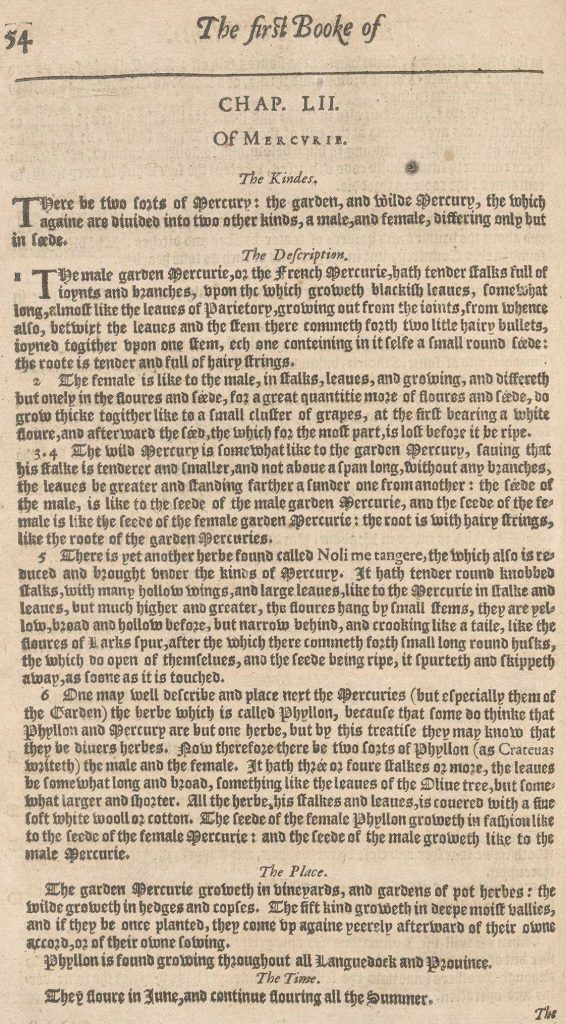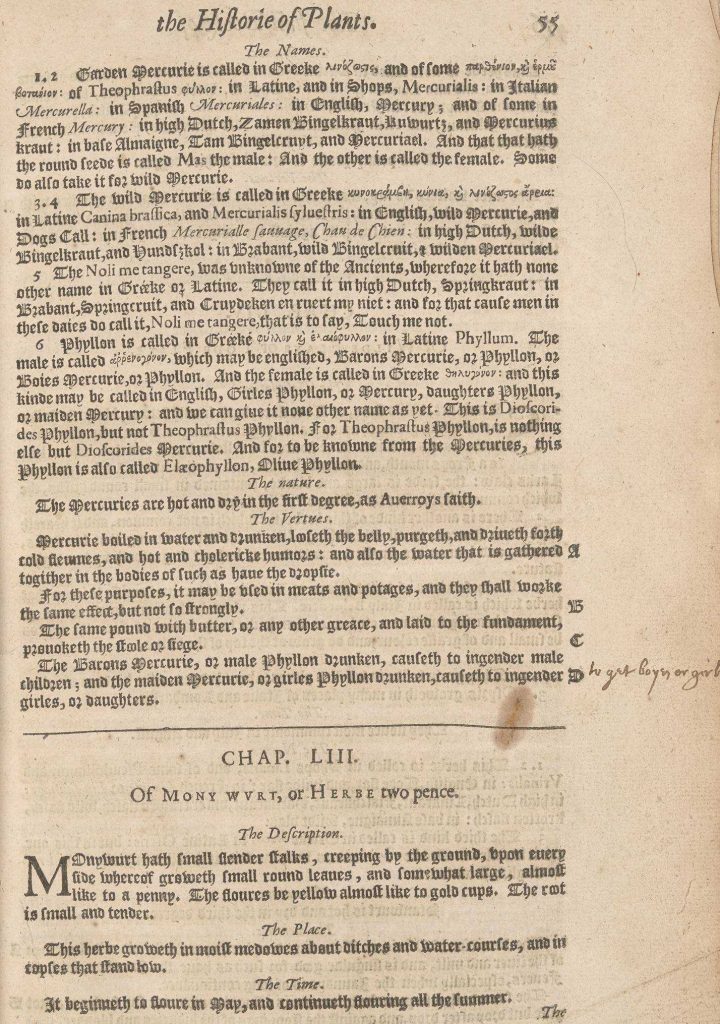October 25, 2023, by Chloe
Marginalia in a Medical Manuscript
This is a guest post by Tabitha Gresty, who volunteered at Manuscripts and Special Collections between April and September 2023, cataloguing medicinal herbs and their uses in remedies from material held here at Manuscripts and Special Collections.
Since working on the Early Modern Recipes Research project, I have been constantly amazed by the breadth of medicine explored within this period. The text I studied was Rembert Dodoens’ A new herbal or historie of Plants, which provides an almost encyclopaedic view of how to use herbs and plants to cure specific illnesses and ailments. However, what is perhaps also fascinating about the text, specific to the volume held by Manuscripts and Special Collections, is the marginalia within its pages.
It is clear to see which herbs were viewed almost as cure-alls given the diversity of their applications mentioned within the text. The text describes these uses as virtues of the plant. For example, by my own count, the different parts of a plantain has 39 recorded uses from jaundice to ‘fires of the belly’. Mugwort was considered to assist with keeping away venomous creatures and travel weariness. Now, obviously, the actual medicinal benefits provided by these plants is highly contentious and, given that poisonous plants such as foxglove are also included within some cures, some of these cures could actually endanger the user further. However, it does demonstrate which of these plants were more readily available, indicated by the frequency of their use. What is also interesting is that certain plants do seem to have affiliations with certain ailments: betony is connected several times with stomach and uterine issues, while water cress is connected with skin troubles such as blemishes and spots. This could possibly indicate a communal medical knowledge whereby certain herbs were widely believed to be linked to certain anatomical features or ailments.

Page 54 from ‘A new herbal, or, Historie of plants’ by D. Rembert Dodoens (Oversize RS164 DOD), discussing Mercury
In addition to the patterns of herbs and remedies, this particular copy of the text is interesting because of the marginalia within its pages. This text is widely annotated by a variety of hands. For example, the very first page of the text is inscribed with a cure for a mad dog bite, possibly a bite from a dog infected with rabies. Some of the annotations directly contradict the recipes. Within the entry for mercury (another example of a potentially dangerous remedy), the recipe itself states that ‘The Barons mercury, or male Phyllon drunken, causeth to engender male children; and the maiden Mercury or girles Phyllon drunken, causeth to ingender girles, or daughters’. However the annotation beside this reads ‘to get boys or girls’. This possibly indicates that the individual who annotated it saw that the remedy had little impact on the gender of the child. Despite the misguided and potentially dangerous nature of this remedy, it is particularly interesting that someone else viewed this cure as mistaken with knowledge specific to their own time period.

Page 55 from ‘A new herbal, or, Historie of plants’ by D. Rembert Dodoens (Oversize RS164 DOD), discussing Mercury, including marginalia
This text is incredibly fascinating as it provides a sense of chronology with early modern medicine. It supplies us with the author’s knowledge, perhaps gathered from the community around them. However, the marginalia provides us with different lenses. The various readers of this text have added their own input and knowledge, perhaps for their own notes or for future readers.
As part of this project, over 3400 records have been created which cover approximately 200 years from the early 1600s to the late 1700s. The research can be accessed in our Reading Room – to find out more, or to book an appointment today, please contact us at mss-library@nottingham.ac.uk.
No comments yet, fill out a comment to be the first

Leave a Reply